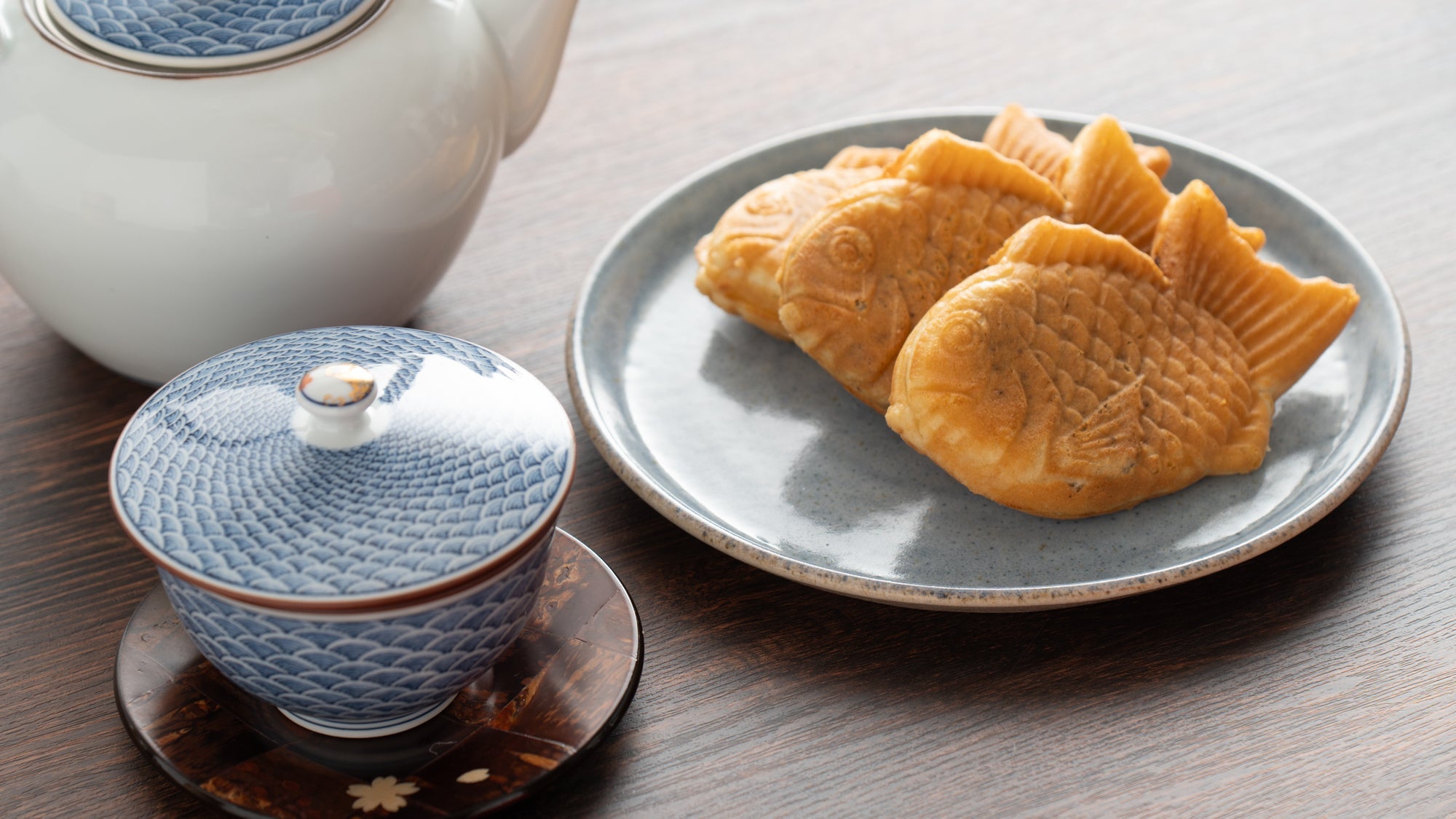
Sweet and Warm: A Taste of Japanese Winter
Written by Team MUSUBI
When you think of winter in Japan, what comes to mind? Is it the stunning snow-covered landscapes of Hokkaido, or perhaps the savory delight of sukiyaki? While these images capture the beauty of the season, Japan’s chilly months are also celebrated for its sweet, warming treats.
From the rich, soothing coziness of oshiruko, flavorful red bean soup, to the delightful crispiness of taiyaki, these traditional delights offer both comfort and nostalgia. Savor the earthy richness of yakiimo, roasted sweet potatoes, or sip on the gentle, fermented goodness of amazake. Each of these treats brings a taste of warmth and tradition, perfect for embracing the season with joy.
Oshiruko
Oshiruko is a heartwarming Japanese dessert often enjoyed during the chill of this season, filling the air with a sense of nostalgia. It is believed to date back to the Heian period (794 CE–1185 CE), making it a long-standing part of Japanese culinary heritage. By the Edo period (1603 CE–1868 CE), oshiruko had further developed as advancements in cooking techniques and the broader availability of sugar allowed for even more delicious versions to emerge. In particular, the Kanto region embraced a variation known as zenzai, a similar dish with a slightly thicker texture and a more robust bean taste.
This traditional treat consists of a rich, velvety red bean soup made from azuki beans and sugar, with soft, chewy pieces of mochi rice cakes nestled inside. The soup has a mildly mellow, earthy essence from the beans, balanced by the chewy texture of the mochi that softens as it absorbs the warmth of the soup. The dessert is deeply rooted in Japanese culture, often associated with family gatherings and seasonal celebrations, particularly around the New Year.
When enjoying this traditional treat, we highly recommend serving it in a lidded lacquerware bowl like the Spear Flower Lacquerware Soup Bowl with Lid. The bowl’s red interior beautifully enhances the contrast of the white mochi pieces floating in the deep red bean soup. The bowl’s glossy black exterior, adorned with delicate golden floral designs, adds an elegant, festive touch.

Pairing oshiruko with the Rabbits in Sunny Spot Bowl crafted from stoneware offers another delightful way to enjoy this comforting dessert. The warmth of the oshiruko gradually radiates through the stoneware, spreading into your hands and warming your entire body. The bowl’s charming rabbits and moon design brings a cozy, homely feel to the experience, making each sip of oshiruko even more inviting on a chilly day.
Taiyaki
Taiyaki is a beloved Japanese street food known for its playful fish shape and warm, comforting taste, making it a favorite treat during the colder months. This iconic snack originated in Tokyo in the early 1900s. Shaped like a tai “Japanese sea bream,” a fish associated with good fortune, this is not only a delicious dessert but also a symbol of luck and prosperity, especially popular at festivals and special events.

Taiyaki’s traditional filling is anko, sweet red bean paste, which lends a rich savor that balances beautifully with the crispy, cake-like exterior. Some modern versions are filled with custard, chocolate, or even savory options like cheese or sweet potato, offering a variety of flavors to suit different tastes. The batter, similar to that of a pancake or waffle, is poured into fish-shaped molds and cooked until golden brown. The result is a perfect harmony of crisp edges, warm filling, and a pleasant aroma that fills the air at food stalls and specialty shops.
In addition to enjoying taiyaki from street vendors, it’s also perfect for savoring slowly at home. Plated on a Blue Aohagi Side Plate, the taiyaki appears as if it’s swimming in water, with the soft blue background beautifully highlighting its golden color, making it look even more enticing. This presentation enhances the visual appeal of taiyaki, transforming a simple snack into a delightful experience.
Serving taiyaki on the Neco Hasami Cat Plate Set adds a charming touch, as the curled-up cat design seems to be cradling the taiyaki in its paws. This playful presentation brings a bit of charm and fun to snack time, making it especially lovely for enjoying with children. It’s perfect for sharing a tender, cozy moment during the winter, creating memories filled with joy.
Yakiimo
Yakiimo, or roasted sweet potato, is also a beloved winter snack in Japan, cherished for its natural sugary richness, warm aroma, and heartwarming charm. Its origins trace back centuries, to a time when sweet potatoes were introduced to Japan during the Edo period (1603 CE–1868 CE). Over time, yakiimo became a staple winter treat, sold by street vendors with their distinct, traditional trucks equipped with hot stone ovens. In the past, during the colder months, the call of "Yakiimo!" would echo through neighborhoods. These days, the familiar call is more often heard through speakers at the entrance of supermarkets, yet the sound still brings a cozy, nostalgic warmth, signaling the arrival of this seasonal treat.

Made with Japanese satsumaimo sweet potatoes, yakiimo has a distinctively, honeyed flavor that deepens as it roasts. Prolonged baking brings out their natural sugars, creating a caramelized, golden interior that’s rich, creamy, and incredibly satisfying. It can also be enjoyed with dairy products like cream cheese, adding a delightful Western twist to the aroma.
Yakiimo is simple to make at home, and serving it on elegant tableware enhances the experience. The Hibino Kokuto Black Mino Ware Rectangle Plate 8.5 in or the RINKA Usuki Oval Long Plate both feature a textured, matte black finish that provides a striking contrast with the golden yellow of the roasted sweet potato. With these plates, even the simplest of foods take on an air of sophistication, making caramelized yakiimo a delight to savor at home.
Amazake
Amazake is a traditional Japanese drink cherished for its gentle mildness and smooth texture. Although its peak season is summer, amazake can also be enjoyed warm, making it especially popular during the winter months. This milky, lightly fermented beverage has a long history and was mentioned in the Nihon Shoki (720 CE), one of Japan’s oldest historical texts.
There are two types of amazake: koji amazake, made from rice, and koji, a fermentation starter, and sake lees amazake, made from sake lees. The first type is alcohol-free, making it suitable for both adults and children, while the latter contains the fragrance of Japanese sake and a small amount of alcohol, offering a more distinct flavor profile.
Today, amazake can be found at New Year festivals, and even in home kitchens, where it is easy to prepare from scratch or enjoy as an instant mix. During winter, it’s especially beloved as a cozy beverage that not only warms the body but also provides a taste of Japanese tradition and heritage.
Enhance your tasting experience by using a traditional yunomi cup. The Yuzu Tenmoku Mino Ware Yunomi Japanese Teacup features a firm, thick base that helps keep amazake warm, while the contrast of white glaze against black beautifully reflects the essence of winter. Choemon DJ Kutani Yunomi Japanese Teacup blends traditional and modern design in a fun and harmonious way, making it perfect for enjoying this classic drink.
As the chill of winter settles in, there’s no better way to experience Japan’s seasonal charm than by indulging in these comforting treats. Whether you're cozied up at home or exploring a bustling winter festival, each bite or sip brings a touch of warmth and tradition that connects you to the heart of Japanese culture. As winter envelops us, indulge in the rich warmth and nostalgic charm of these savors—proof that the simplest joys often leave the deepest impressions. During the chill of the season, find solace in the comforting embrace of these familiar tastes—a gentle reminder of the beauty in life’s simplest pleasures.














Leave a comment
This site is protected by hCaptcha and the hCaptcha Privacy Policy and Terms of Service apply.